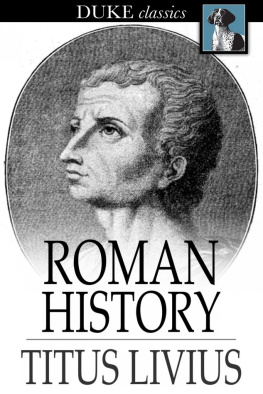OXFORD WORLDS CLASSICS
HANNIBALS WAR
BOOKS TWENTY-ONE TO THIRTY
TITUS LIVIUS (LIVY), the historian, was born in Patavium (modern Padua) in 64 or 59 BC and died in AD 12 or 17 in Patavium, surviving therefore into his late seventies or early eighties. He came to Rome in the 30s BC and began writing his history of Rome not long after. There is no evidence that he was a senator or held other governmental posts, although he was acquainted with the emperor Augustus and his family, at least by his later years. He appears to have had the means to spend his life largely in writing his huge history of Rome, Ab Urbe Condita or From the Foundation of the City, which filled 142 books and covered the period from Romes founding to the death of the elder Drusus (7539 BC). Thirty-five books survive: 110 (753293 BC) and 2145 (218167 BC).
J. C. YARDLEY has been Professor and Head of Classics at the Universities of Calgary and Ottawa and is a former President of the Classical Association of Canada. He has also translated The Dawn of the Roman Empire (Books 3140 of Livys history) for Oxford Worlds Classics, as well as Quintus Curtius History of Alexander for Penguin Classics (1984) and Justin for the American Philological Association Classical Resources series (1994) and (Books 1112) for the Clarendon Ancient History series (1997). His most recent books are Justin and Pompeius Trogus (2003) and (with Waldemar Heckel) Alexander the Great (2004).
DEXTER HOYOS was born in Barbados, studied at Oxford, and teaches Roman history and historians, and Latin, at Sydney University. His most recent publications include Unplanned Wars (1998), on the causes of the first two Punic Wars, and Hannibals Dynasty: Power and Politics in the Western Mediterranean 247183 B.C. (2003).
OXFORD WORLDS CLASSICS
For over 100 years Oxford Worlds Classics have brought readers closer to the worlds great literature. Now with over 700 titlesfrom the 4,000-year-old myths of Mesopotamia to the twentieth centurys greatest novelsthe series makes available lesser-known as well as celebrated writing.
The pocket-sized hardbacks of the early years contained introductions by Virginia Woolf, T. S. Eliot, Graham Greene, and other literary figures which enriched the experience of reading. Today the series is recognized for its fine scholarship and reliability in texts that span world literature, drama and poetry, religion, philosophy, and politics. Each edition includes perceptive commentary and essential background information to meet the changing needs of readers.
Refer to the to navigate through the material in this Oxford Worlds Classics ebook. Use the asterisks (*) throughout the text to access the hyperlinked Explanatory Notes.
OXFORD WORLDS CLASSICS

LIVY
Hannibals War
Books Twenty-One to Thirty

Translated by
J. C. YARDLEY
With an Introduction and Notes by
DEXTER HOYOS


Great Clarendon Street, Oxford OX2 6DP
Oxford University Press is a department of the University of Oxford.
It furthers the Universitys objective of excellence in research, scholarship,
and education by publishing worldwide
in Oxford New York
Auckland Cape Town Dar es Salaam Hong Kong Karachi
Kuala Lumpur Madrid Melbourne Mexico City Nairobi
New Delhi Shanghai Taipei Toronto
With offices in
Argentina Austria Brazil Chile Czech Republic France Greece
Guatemala Hungary Italy Japan Poland Portugal Singapore
South Korea Switzerland Thailand Turkey Ukraine Vietnam
Oxford is a registered trade mark of Oxford University Press
in the UK and in certain other countries
Published in the United States
by Oxford University Press Inc., New York
Translation J. C. Yardley 2006
Introduction, Notes and other editorial matter Dexter Hoyos 2006
The moral rights of the authors have been asserted
Database right Oxford University Press (maker)
First published as an Oxford Worlds Classics paperback 2006
All rights reserved. No part of this publication may be reproduced, stored in a retrieval system, or transmitted, in any form or by any means, without the prior permission in writing of Oxford University Press, or as expressly permitted by law, or under terms agreed with the appropriate reprographics rights organization. Enquiries concerning reproduction outside the scope of the above should be sent to the Rights Department, Oxford University Press, at the address above
You must not circulate this book in any other binding or cover
and you must impose this same condition on any acquirer
British Library Cataloguing in Publication Data
Data available
Library of Congress Cataloging in Publication Data
Data available
Typeset in Ehrhardt
by RefineCatch Limited, Bungay, Suffolk
Printed in Great Britain by
Clays Ltd, St Ives plc, Suffolk
ISBN 0192831593 9780192831590
1
For
Andrea, Elaine, Jane, Camilla, Jann, and Barbara
CONTENTS
INTRODUCTION
Livy and his history
Titus Livius was born at Patavium in northern Italy, todays Padua, probably in 64 BC, and died there probably in AD 12; his familys communal epitaph may still be seen. He began writing his history From the Foundation of the City (Ab Urbe Condita) around 27 BC, just as Romes latest supreme leader, Augustus, was consolidating his primacy over the city and the empire. Starting with the origins of Rome, he concluded with the year 9 BC in Book 142, an average yearly output of nearly four sizeable books. Of these, only 35 (110 and 2145) survive, though luckily a collection of epitomes or rsums of nearly all 142 is extant.
The history made Livy famous in his own lifetime: there is a story of an admirer from Gades (Cdiz) in Spain who travelled to Rome simply to see the man of renown, and then went home. Livy was on friendly terms with Augustus, but From the Foundation of the City was not a commissioned work or propaganda piece for the new regime: Livy openly wondered whether it would have been worse or better for the Roman people if Julius Caesar had never been born, and accorded enough praise to Caesars foe Pompey for Augustus to tease him with being a Pompeianperhaps a punning joke based on his Patavine origin.
Books 2130 of From the Foundation comprise our most detailed and exciting ancient account of the Second Punic War, Hannibals war against Rome. The two warring states, Rome and Carthage, were supposedly founded within a few decades of each other: Carthage in 814, Rome in 753. It will help a better understanding of Livys narrative to summarize the events that led to their rivalry.
Rome and Carthage: two republics
Both Rome and Carthage had traditions of eastern ancestryRome descended from Trojan refugees, Carthage the creation of Dido, a princess of Tyre in Phoenicia (roughly todays Lebanon), fleeing tyranny at home. The favourable geography of both cities made them locally powerful from early times. Romes strong site on seven hills beside the Tiber commanded the best routes along that section of Italys coast and between sea and interior. Carthage, on a diamond-shaped peninsula overlooking the narrowest stretch of the Mediterranean, was not the oldest Phoenician colony but the best positioned for western commerce and communications.
Next page






